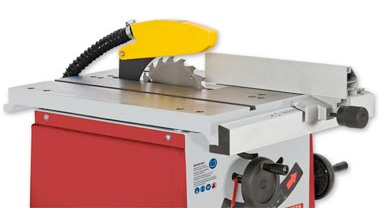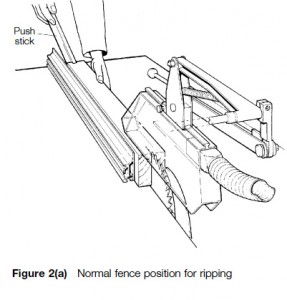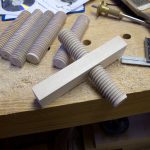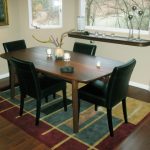We may receive a commission when you use our affiliate links. However, this does not impact our recommendations.
 Over the holidays, I saw the same question asked on both an American and British woodworking forum. The poster had received a new table saw for Christmas, had no experience and wanted to learn how to use the saw safely. One of the responses on the British forum was this:
Over the holidays, I saw the same question asked on both an American and British woodworking forum. The poster had received a new table saw for Christmas, had no experience and wanted to learn how to use the saw safely. One of the responses on the British forum was this:
Whilst the risk of kickback is real, good sense and technique, as with any tool, is the key to safe usage. Just don’t read any American magazines or books on how to use them.
While it’s easy to poke fun at the British for their quaint use of our language, their fondness for strange-flavored potato chips and their inability to make a car that doesn’t leak oil, it’s hard to argue with their approach to table saw safety. The picture at right is one of the least expensive “Saw Benches” (table saw to us) available at Axminster Tools. Take a look at the fence and guard and you will see some significant differences.
Unlike Americans, where we generally remove the guard the first time it gets in the way (and rarely put it back), the British tend to leave their guards in place, and find other ways to do things – making grooves in particular – rather than work with an exposed blade. One of the reasons for this is that their guard systems are well-designed and useful. There aren’t any anti-kickback pawls to get in the way, there is a simple attachment of the guard to the riving knife and the guard includes dust extraction.
 The other feature that is noticeably different is the fence. This style of fence was once available on this side of the Atlantic from Delta, but it never really caught on. The biggest difference is that the fence is adjustable from front to back, with the normal position for ripping seen at left. The far end of the fence is set so that it doesn’t go beyond the gullet of the saw teeth. That effectively prevents kickback – the work can’t be trapped between the fence and the back of the blade. The fence extrusion is used in a low position when working with thin stock to allow room for the operator to better control the push stick. The fence can also be pulled back behind the blade and used as a stop when crosscutting.
The other feature that is noticeably different is the fence. This style of fence was once available on this side of the Atlantic from Delta, but it never really caught on. The biggest difference is that the fence is adjustable from front to back, with the normal position for ripping seen at left. The far end of the fence is set so that it doesn’t go beyond the gullet of the saw teeth. That effectively prevents kickback – the work can’t be trapped between the fence and the back of the blade. The fence extrusion is used in a low position when working with thin stock to allow room for the operator to better control the push stick. The fence can also be pulled back behind the blade and used as a stop when crosscutting.
The British Health and Safety Executive has some interesting publications regarding the safe use of table saws and other woodworking equipment. Here is a link to WIS-16 a pamphlet titled “Circular Saw Benches-Safe Working Practices.” It’s short and to the point, easy to understand and it gives reasons behind the rules as well as safe methods to use a table saw. It was easy to find in an Internet search, so I decided to compare it with what OSHA, the American equivalent to the HSE, has available. Not so easy to find, and clearly not as useful. It basically lists some equipment but makes no mention of specific tasks that might be more dangerous than others, or how to assess and avoid risks. Here is a link to the OSHA “eTool Table Saw” page.
Sometimes the British get things right.
All the things the Brits don’t think you should read are compiled in our digital publication The Essential Guide to Table Saws. Learn how to set up and use your table saw safely and efficiently.
Here are some supplies and tools we find essential in our everyday work around the shop. We may receive a commission from sales referred by our links; however, we have carefully selected these products for their usefulness and quality.










It is nice to know we Brits may sometimes get things right, and I would like to compliment you on your clear and succinct article, but I was a little confused as to WHOSE language it was written in. Actually, joking aside, did you know that all books originating from the UK or other English speaking countries are ‘translated’ into American English before publication in the USA. ‘Quaint’ it may seem, but it represents a hell of a lot of people – the UK’s 60 million being only a small fraction.
Keep up the really good work
Ray Swann
Besides the other differences in woodworking practice between our two great nations divided by a common language, do Brits always cut safe bevels with the blade tilted toward (or towards) the fence (see Fig 2(b) of WIS-16)?
OK Boys and Girls;I have never done this before so I hope I do it right.What I have done is use a table saw,alot.if I make it to July I will be sixty and I first started using powertools when I was eight,and yes I have ten fingers.I am a proffesional carpenter so I use it almost every day.On the jobsite I use an old mid-fifties Craftsman castiron 10 inch table saw.It is my favorite powertool period.No saftey devices except a shut off switch and a push stick.My rule? Work in a secure area,understand what you are attemting to do, and how the mach is going to react.Have a sharp blade,keep your mind focused;no beer warm or cold.If you are using a table top saw make sure it is on a table and secure.not on the ground.Now for the saw stop technology;If my Craftsman had been equipped with a saw stop when it was new,do you think it would still work correctly?I don’t.I don’t think if even was alot newer,I think if they are made like all the other junk today.I think it would instill a false sense of confidence that would lead to worse injuries and alot more lawsuits.If you don’t know how to use it safely,LEAVE IT ALONE!If we let the Government run any more of our lifes soon you will need a permit to poop.Alot of people would not be able to afford the saw and any wood for aproject.I think that would be a tradgedy.One more thing;I’m American and I speak and spell yankee.So far that’s my choice as an American.My Father was an English Major and never biult a bird house
As editor of British Woodworking magazine I have written extensively about tablesaw safety, though I hope not rudely about American methods. Each to their own. It is surely up to individuals to make their choices. Perhaps our more cautious approach comes from the mixed blessing of shared healthcare funding! Personally I just want people to feel safe enough to get involved and have a go, and want to keep going, and develop the skills and the understanding of when operations are likely to be dangerous or not. I fear that too much reliance on safety features isolates woodworkers from that learning process, while lack of awareness of safety issues is likely to compromise the enjoyment of our amazing craft.
Nick Gibbs
http://www.britishwoodworking.com
RE: Table Saw (Sawbench)use, it is my least favorite power too. It doesn’t have any guards. It is an early ’50’s 1st generation contractor’s saw. I stand to one side and use push sticks. Do it and get it over with. Total concentration.
Umm…Before anyone gets to worked up about whose language it is (and its proper use), ‘English’ is pretty much a mongrel tongue. Something more than half of it is of Anglo-Saxon origin with many additions and influences from Norse, Scots and Irish Gaelic, the Romance languages and Latin directly, as well as other sources from across the globe as the British empire exerted its influence. Another factor is that ‘English’ takes in new arrivals lock, stock, and barrel without extruding them through the colloquial and grammatical die that, for instance, the French do. This gives rise to the many exceptions to the rules (e.g. ‘i before e except after c’). That and the sheer number of words (2-300,000 vs. ~60,000 for Finnish) are what make it so hard for others to learn as a second language.
A final note. Youse shouldn’t use youse unless youse use it in the proper use.
Safe sawing everyone.
There are several major factors that contribute to the differences in woodworking equipment design between North America and Britain/Europe.
1) Historically, European woodworkers were usually specialized tradesmen’s who study their craft since childhood. In North America, woodworking was just on of the vast array of generic skills North American acquired in settling the continent. The pre-1950s American farmer/rancher types could do almost anything: woodwork, carpentry, plumbing, electronics, welding, machinist, engine repair, pumping and irrigation, etc. My grandfather and uncles of the pre-WWII generation could do almost anything because at some point they had to.
Specialist pay good money for fine tools. Generalist have to buy a wide array of tools, sometimes just one off for a specific job. Historically, European tools are finely designed for high skilled use. Historically, America tools tends to be “good enough”, rugged and requires less specialized skill.
2) Labor cost in Europe have historically always been higher than in America and that has increased in the 20th century. Higher labor cost mean its more cost effective to sink capital into tools so that fewer workers can do more work.
3) Historically, vastly more Americans were self-employed than in Europe. People who work for themselves are more tolerant of issues like safety or inconvenience than people working for others because they feel in control of the issue. By contrast, the literature of design in Europe is full of references to the tools and machines that are forced upon workers by employers and guilds. European designers began to emphasize safety at least in part because of the high degree of class conflict in European monocultures.
4) Americans are highly anti-elitist. No matter how much money he might have, no American man wants to convey the impression that he is afraid to get his hands dirty. Culturally we associate fineness with effete elitism. We don’t like tools that look to fine or “prissy” for no particular reason.
This sometimes becomes comical with toolmakers putting cosmetic bulges, ridges etc to make the tool look more rugged and utilitarian.
My first impression of the saw pictured at the top of the post was that it was one of those “toy” miniature saws used by model makers. All the dimensions are wrong. It doesn’t look like any saw you would see being used to build a house in Texas.
I imagine one could right a book about how culture and history influences the design of woodworking tools around the world. Might do that when I retire.
Those of you with Beismeyer style fences should check out Very Super Cool Tools, a new company that makes a replacement fence (using your existing rails) that allows you to do everything that this article talks about.
http://www.vsctools.com
Uh, Mr. Lang, the Delta Unifence has the slide back feature and the half length fence attachment. It also has the thin stock feature of a rotating fence as pictured above. In my opinion the Unifence is far superior to the more commonly seen Beisemeyer or most any other stock table saw fence.
I have no argument about the safety of table saws, but I wonder about router safety. How can a router endanger my fingers if I hold it by the handles? The scariest way I can think to use a router is in a router table. Many router tables have cutter guards and guide pins, and using the router without those aids is risky.
Rolls Royce, owned by the Germans but British made, I don`t think they leak oil!
The best things we gave you was the English language but you seem determined to destroy it. It is not a dado but a groove and if you are a woodworker rather than a machine setter you generally cut it with a grooving plane or carcase saw,chisel and router plane (A tool that will not take your finger off and can be used without eye or ear protection.). It is a rebate not a rabbet… always was pronounced as rebate unless you came from Norfolk. Its not a shuting board but a “strait as an arrow” shooting board. It is not “in a pinch” but “at a pinch”. A pinch is a narrow gap in a wall that a man or a dog can slip through but cattle cannot. You keep leaving out words such as “of” and putting words like “also” in the wrong place. Leverage is pronounced as “leeverage” and not as you spell it. I could go on as it is always amusing to make fun when people get my language wrong.
HOWEVER I have generally learnt to translate automatically. The problems arise when you use trade names of products that have never been seen here and then we simply do not know what you are talking about. Similarly an 8 x 4 or 8/4 piece of wood here would be 8″ wide by 4″ thick so we get a little confused.
More seriously the cost of shipping between us has been allowed to get out of hand. Even small things such as books cost more in shipping charges than the item itself. That seems to be the problem……we are not using shipping but aircraft. OK it might take ten days to get here but I can be patient. The USPS and the Royal Mail need to get their act together. Or should that have been acts?
It is NOT illegal to fit dado heads to saws in the UK.
The HSE state it is perfectly acceptable to use saws fitted with a dado blade if the saw table is designed to accept it.
Most amateur/hobbist saws sold in the UK are purposely fitted with a spindle that is too short – but there are others which will take a dado set.
See here (if you have the time 🙂 )
http://www.greatbritishwoodshop.co.uk/Tools/HealthandSafety/tabid/418/language/en-US/Default.aspx
Roger
Hey, Robert, whilst I appreciated the article very much, I must comment on your ‘throwaway line’ – “While it’s easy to poke fun at the British for their quaint use of our language”, I consider it necessary to remind you just whose language it was, and is. Language in all places is always dynamic in change, but ‘correct’ use of English is as important as avoiding a badly cut dovetail. Thanks for a well written magazine!
I don’t get it; I was taught table saw etiquette once, as a teenager, in passing and I think I’ve experienced the dreaded and much-spoken-of kickback once with a table saw. On the other hand, every single time I use a router I’m afraid I’ll take my fingers off. I’ve pored over safety manuals, tips, tricks, and have picked the brains of woodworking colleagues, but I’m convinced that routers will never feel like a safe tool. I have no idea why brits would feel it better to cut dadoes with a router rather than a ts.
Just looked at some of the Jet offerings through Axminster. Shipping cost is probably outrageous, but there are a lot of really nice features on some of those saws that aren’t offered at all to the U.S. market.
Having been present at a nasty accident featuring an unguarded saw bench, I’m all in favour of good practice and I think I’m correct that here in the UK you cannot fit dado sets to the arbor on newish saws due to safety regs so there is not really a good case for removing the guards apart from fitting a crosscutting sled which you can protect by overhead means